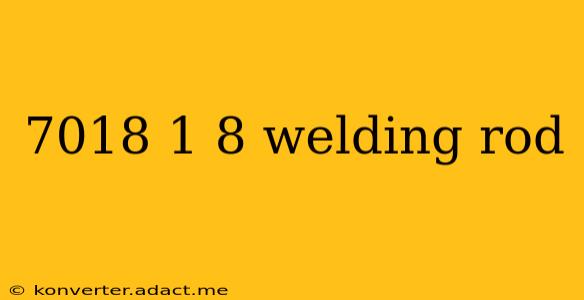The seemingly cryptic code "7018 1/8"" refers to a specific type of welding rod, crucial for various welding applications. This guide delves into the specifics of this popular choice, explaining its properties, uses, and characteristics. Understanding this designation is key to selecting the right rod for your project, ensuring strong and reliable welds.
What Does 7018 Mean in Welding Rods?
The "7018" designation isn't arbitrary; it's a standardized code conveying vital information about the rod's properties. Let's break it down:
-
70: This indicates the tensile strength of the weld metal. A tensile strength of 70,000 psi (pounds per square inch) means the weld is exceptionally strong and durable.
-
18: This signifies the rod's classification. The "1" denotes that the rod is designed for all-position welding (meaning it can be used in any position, including overhead). The "8" specifies that the rod has low-hydrogen characteristics. This is critical for preventing hydrogen cracking in the weld, a common problem leading to weld failure. Low-hydrogen rods require careful storage and handling to maintain their low-hydrogen properties.
What is the Significance of the 1/8" Diameter?
The "1/8"" part refers to the diameter of the welding rod. This is crucial for selecting the appropriate amperage setting on your welding machine. A thicker rod requires a higher amperage to melt properly, while a thinner rod needs less. Using the wrong amperage can result in poor weld quality, excessive spatter, or even damage to your equipment.
What are the applications of 7018 Welding Rods?
7018 rods are exceptionally versatile and popular for several reasons:
-
High Strength: The high tensile strength makes them ideal for applications requiring significant structural integrity, such as pipelines, pressure vessels, and heavy machinery.
-
All-Position Welding: Their ability to be used in any position simplifies welding tasks and reduces the need for specialized techniques.
-
Low Hydrogen Content: This minimizes the risk of hydrogen cracking, ensuring superior weld quality and longevity.
How do I properly store 7018 welding rods?
Proper storage of low-hydrogen rods is paramount. Exposure to moisture can compromise their low-hydrogen properties, leading to potential weld defects. Always store them in a dry, airtight container, preferably a dedicated oven designed for electrode drying. Following the manufacturer's storage recommendations is crucial for maintaining the integrity of these important welding supplies.
What are the advantages of using 7018 welding rods?
The advantages of using 7018 rods are numerous:
-
Superior Strength: They produce welds with exceptionally high tensile strength.
-
Versatility: They can be used in any welding position.
-
Low Hydrogen Cracking: They significantly reduce the risk of weld cracking.
-
Excellent Weld Quality: They produce clean, smooth, and consistent welds.
-
Widely Available: They are readily available from most welding supply distributors.
What are some common mistakes when using 7018 welding rods?
Avoiding these common mistakes will greatly improve your weld quality:
-
Incorrect Amperage: Using too high or too low an amperage can lead to poor penetration, excessive spatter, and lack of fusion.
-
Improper Storage: Exposing the rods to moisture negates their low-hydrogen properties, increasing the risk of cracking.
-
Poor Technique: Improper welding techniques can lead to inconsistent welds and potential defects.
In conclusion, understanding the specifications of 7018 1/8" welding rods is vital for any welder. By paying attention to details like the diameter, proper storage, and amperage settings, you'll achieve strong, reliable, and durable welds, meeting even the most demanding project requirements. Remember to always consult the manufacturer's instructions for the most accurate and up-to-date information on usage and safety.
